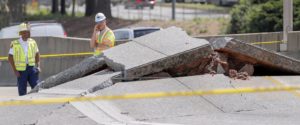America’s infrastructure is crumbling, sending states scrambling for ways to fund the rebuilding of their worn highway systems. Increasing the gas tax is a perennial solution, and now, it is getting attention from the White House.
The federal government levies an excise tax of 18.4 cents per gallon of unleaded fuel and 24 cents on diesel fuel. States gas taxes vary from state to state, but range from a fraction of a cent to more than 50 cents on each gallon.
The federal gas tax is not indexed to reflect inflation. It has not gone up since 1993, although inflation has risen by 64.6 percent.
On May 2, President Donald Trump suggested the possibility of a federal gas tax increase in an interview with Bloomberg.
“(I’ve) had the truckers come to see me, that if we earmarked money toward the highways that they would — that they would not mind a tax — you know, gas tax or some form of tax,” Trump told Bloomberg.
According to the Federal Highway Administration, the U.S. has $836 billion in needed repairs and improvements to roads and bridges, plus an additional $90 billion needed to fix public transit systems, the AP reported.
A dozen states join the push
On Jan. 1, six states implemented higher gas taxes, including Pennsylvania, which raised its state tax on gas by about 8 cents per callon to 58.3 cents per gallon, and Michigan, which raised its state gas tax 7.3 cents to 26.3 cents per gallon. Nebraska, Georgia, North Carolina and Florida, also raised their state gas taxes, according to Forbes.
Michigan also increased registration fees on electric cars, to counter for their lower gas consumption. California will implement a similar measure in November, along with a higher gas tax.
So far this year, five more states have raised gas taxes, and increases are up for debate in more state legislatures.
The gas tax isn’t generally a divided issue; in many states, bipartisan support is garnered for the proposals. Traditionally red states, such as Tennessee and South Carolina, have passed gas tax increases since Jan. 1.
One exception to the gas tax rush is New Mexico, where the state legislature voted to raise the tax by 10 cents a gallon, only to have it vetoed by Gov. Susana Martinez.
New Mexico’s gas tax is one of the lowest in the country, at just 17 cents a gallon.
These gas tax increases have taken a long time to come back. Among the states that increased taxes, the average time gap since the last tax increase is 19 years. Until recently, gas taxes had little support, but the infrastructure crisis has caused them to gain popularity.
They took their time
A Governing analysis in 2015 found that in nearly two-thirds of states, the state gas tax has not kept up with inflation. That number does not include the most recent increases.
Alaska has gone the longest without an increase in a gas tax, according to the Institute on Taxation and Economic Policy. It has not seen one in 45 years. Alaska Gov. Bill Walker has expressed support for the idea, and proposed an increase the gas tax, according to Alaskan NBC-affiliate, KTUU.
Oklahoma has gone the second longest, with nearly 30 years without an increase. The Oklahoma state legislature recently cut funding to the state Department of Transportation, hoping that a gas tax in the future may supplement the cut, according to the Tulsa World.
According to a report by the Organization for Economic Coordination and Development, the United States has the second lowest gas tax among the 34 countries with advanced economies around the world.
Supporters of a gas tax have claimed that in the long run, improved roads and infrastructure will save individuals money, leading to less damage to vehicles. Others, including Trump, argue that roads in poor condition hurt business and hinder the movement of goods.
Opponents say the U.S. gas tax system doesn’t need vast improvement and instead of an increase in taxes, the U.S. needs a revamp of its funding structure.
With so many states approving and considering gas tax increases, it’s clear that gas tax increases are an increasingly popular funding mechanism as a repair strategy.
Micheline Maynard weighs in: What’s missing in the gas tax debate is a discussion of the way people are using transportation. Of course, no one likes potholes and crumbling highways are a threat. But, as Americans reconsider how — and how often — they get around, the increase in these gas taxes might not be as effective a funding tool as it could have been five, 10 or even 20 years ago. Is it really the way for pay for the future of transportation?

